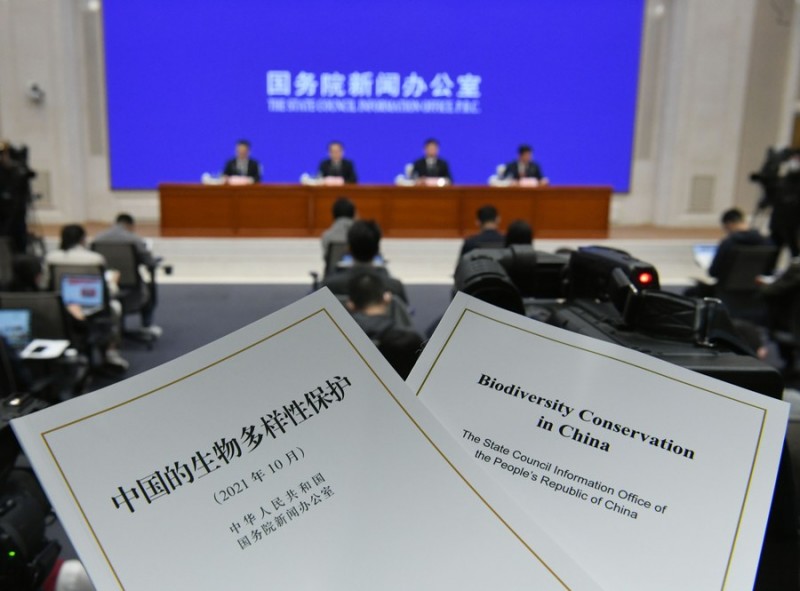China on Friday issued the country's first white paper on biodiversity, detailing how the world's most biodiverse country has endeavored to protect its ecosystems in pursuit of harmony between humans and nature.
The white paper, titled "Biodiversity Conservation in China," came days ahead of a key United Nations (UN) biodiversity meeting to be held in the southwestern Chinese city of Kunming.
The move bears great significance as the UN begins its Decade of Action after the world sought to reach the Aichi Biodiversity Targets during the 2011-2020 period, Zhao Yingmin, vice minister of the Ministry of Ecology and Environment (MEE), said at a press conference on Friday.
The vice minister said that China's implementation of the Aichi Biodiversity Targets was better than the global average, as the country recorded expectation-beating progress in three of the 20 goals and key progress in 13 others.
The issuance of the white paper will increase the international community's understanding of the country's efforts in the sector, contributing Chinese wisdom to global biodiversity protection, Zhao said.

Photo taken on Oct. 8, 2021 shows a press conference wher the white paper "Biodiversity Conservation in China" is issued by China's State Council Information Office in Beijing, capital of China. (Xinhua/Jin Liangkuai)
CHINA'S BIODIVERSITY CONSERVATION
To address biodiversity loss and ecosystem degradation, China has taken creative and up-to-date approaches, forming a new pattern of biodiversity conservation, according to the white paper.
China was the first globally to propose and implement the red line strategy for ecological conservation, an important institutional innovation in its land-use planning and eco-environmental reform.
The country's proposal "Drawing a 'Red Line' for Ecological Protection to Mitigate and Adapt to Climate Change" has been seleced by the UN as one of the 15 best Nature-based Solutions around the globe.
Liu Dong, a senior researcher at the Nanjing Institute of Environmental Sciences under the MEE, said that such an innovative strategy allows the most important areas to be controlled, producing the greatest environmental benefits from the smallest areas, and drawing attention in the international community.
China has also optimized its in situ and ex situ conservation, making efforts to build a protected area system with national parks as the mainstay, and to launch systematic campaigns to save endangered species, the document said.
A thriving ecosystem is proof of the country's biodiversity conservation progress. According to the white paper, the population of giant pandas in the wild has grown from 1,114 to 1,864 over the past four decades, while the Asian elephant population in the wild has grown from 180 in the 1980s to about 300 at present.
To improve biodiversity governance, China has elevated biodiversity conservation to a national strategy, rolling out measures to improve the legal and policy frameworks, expand oversight on law enforcement and encourage public participation, the document said.
AMBITIOUS YET VIABLE GOALS
Despite the progress achieved, the pressure on global biodiversity is still aggravating as the trend of biodiversity loss has not been fundamentally reversed, Zhao said.
At the upcoming UN biodiversity meeting, participants are expected to sit around the discussion table and delineate a "post-2020 global biodiversity framework." Experience over the past decade will be reviewed and transformative changes in the global biodiversity drive might take place, Zhao said.
The vice minister said that ambitious yet feasible biodiversity goals and strategies should be put on the table.
He said he expects the next decade's global biodiversity goals to boost the world's ambition and confidence, but also underscored that participants should fully consider the accessibility and feasibility of new targets when drawing a biodiversity blueprint.
"The raging pandemic has reminded us that humans and nature have a shared future. The international community needs to intensify cooperation in the face of the challenges of biodiversity loss and ecosystem degradation," Zhao said.
Over the past years, China has firmly practiced multilateralism and actively carried out international cooperation on biodiversity conservation, with stronger South-South cooperation in biodiversity conservation and improved multilateral cooperation mechanisms for green development under the Belt and Road Initiative, according to the white paper.
Wei Fuwen, an academician with the Chinese Academy of Sciences, said that the biodiversity conservation drive entails a global perspective as many species live not only in China, but also in surrounding countries.
"China will continue to actively participate in and promote international cooperation on global biodiversity through various means," Wei said.
(Video reporter: Yang Zhigang, Video editors: Liu Ruoshi, Zhang Yuhong)

